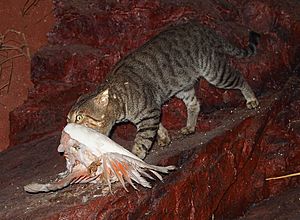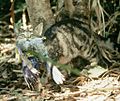Cats in Australia facts for kids

Cats are popular pets in Australia, but they are also considered an invasive species. This means they are not native to Australia. Europeans brought cats to Australia in the early 1800s. Australian animals had not grown up alongside cats. Because of this, cats have a much bigger impact on the environment here than in other parts of the world. Today, there are about 2.7 million pet cats and between 2.1 and 6.3 million feral cats in Australia. Both pet and feral cats have caused many native Australian animals to become extinct. For example, cats are thought to have helped cause the extinction of 22 unique Australian mammals since Europeans arrived.
To keep Australia safe from diseases, any cats brought into the country must follow strict rules. These rules are set by the Department of Agriculture, Fisheries and Forestry.
Contents
When did cats arrive in Australia?
Cats were first brought to Australia around 1804. By 1820, some cats had become feral (wild) near Sydney. People started worrying about the cat problem in the early 1900s. A study in the 2010s found that each feral cat kills about 740 wild animals every year.
Pet Cats in Australia
Pet cats also hunt and kill wild animals. Each pet cat in Australia kills an estimated 75 animals every year. In 2016, about 29% of Australian homes had a pet cat.
Wild Feral Cats
Feral cats are one of the biggest invasive species in Australia. They have caused many native animals to decline or disappear completely. They especially harm birds that nest on the ground and small native mammals. Feral cats also make it hard to bring threatened animals back to areas where they used to live. This is because the cats quickly kill the newly released animals.
Many Australian environmental experts say that feral cats have caused a huge problem for nature in Australia. They live in almost every ecosystem except dense rainforest. They have been linked to the extinction of several marsupial and placental mammals.
Scientists did an experiment in Heirisson Prong in Western Australia. They compared small mammal populations in areas where foxes and cats were removed, where only foxes were removed, and where nothing was removed. They found clear proof that feral cats hunting can cause native mammal numbers to drop. This problem is even worse when fox numbers are low. Cats might also help control introduced rabbits, especially in dry areas. Rabbits themselves cause a lot of damage to the environment. Cats are also believed to have played a part in the extinction of the only mainland bird species lost since European settlement, the paradise parrot.
In Australia, feral cats have very few natural predators. Only dingoes and wedge-tailed eagles hunt them. This means that where dingoes and eagles are not present, cats become apex predators, meaning they are at the top of the food chain.
Since 2016, there has been a program on Kangaroo Island to remove all feral cats. They hope to get rid of the island's 3,000 to 5,000 feral cats by 2030. The 2019-2020 bushfires made this harder. The regrowing plants create good places for cats to breed and hide.
Sometimes, people in Australia claim to see very large wild cats, like cougars. While this is rare, very big feral cats are sometimes found. In 2005, a huge cat was shot in the Gippsland area of Victoria. DNA tests showed it was a feral cat.
Some Indigenous Australians use traditional methods to manage local populations of feral cats.
Mystery Cats
There have been many sightings of mystery cats in Australia. These include the Gippsland phantom cat and the Blue Mountains panther. People sometimes report seeing these large, unknown cats.
Images for kids



